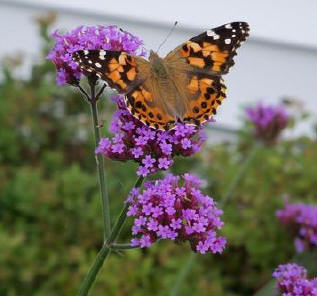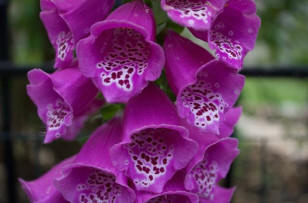
(11/13) Nature is just so amazing. The more you learn, the more fascinating it becomes. We know that insects are needed to pollinate nearly all the edible and ornamental plants that we enjoy in our gardens. Without those insects, a huge percentage of the food we eat and the flowers we love would no longer exist.
Have you ever wondered how and why those insects find the flowers they pollinate? Obviously, the WHY is because they are looking for food. Many insects eat pollen, or feed it to their young, but, mostly, as they approach the flower, they are looking for the nectar. All pollinators drink nectar. In their quest for the nectar, they brush against the pollen and spread it
around the flower or to other flowers. It is purely accidental on the part of the bee that it is making it possible for the plant to procreate. The answer to HOW they find the pollen contains some amazing facts, and provides part of the explanation as to why diversity of plants in your garden is so important.
Color
 One trick which nature uses to lure pollinators to a flower is color. The bright colors of the flowers attract the pollinator and entice it toward the nectar. Pollinators are attracted to different colors because
of the different photoreceptors present in their eyes. Bees are the super heroes of the pollinator world because they have the most highly developed eyes. In fact, they have five eyes. Bees have a much broader range of color vision than humans, and they can see things in ultra-violet light, which we cannot.
One trick which nature uses to lure pollinators to a flower is color. The bright colors of the flowers attract the pollinator and entice it toward the nectar. Pollinators are attracted to different colors because
of the different photoreceptors present in their eyes. Bees are the super heroes of the pollinator world because they have the most highly developed eyes. In fact, they have five eyes. Bees have a much broader range of color vision than humans, and they can see things in ultra-violet light, which we cannot.
Birds of all kinds are also important pollinators. The well-loved hummingbirds are known to be attracted to the color red. A big patch of red salvia or native red honeysuckle is almost guaranteed to be visited daily by hummingbirds. That doesn't mean that hummingbirds will only go to red flowers. They also love Black and Blue Salvia, which, of course, is black and blue.
Hummingbirds’ beaks and tongues are very long so they are built to drink nectar from tubular flowers. Red is the color that first attracts them. Once they are in your yard, they will visit any other flowers that meet their needs.
 Surprisingly, bees don't really see red. They base their color perception on blue, green and ultraviolet light. When a bee looks at a red flower, that flower simply fades into the green foliage background. The best colors
to attract bees are blue, violet, and purple. Several articles I read suggested that in order to avoid bees while working in the garden, you should wear red. Avoid wearing yellow because it attracts wasps and other stinging insects.
Surprisingly, bees don't really see red. They base their color perception on blue, green and ultraviolet light. When a bee looks at a red flower, that flower simply fades into the green foliage background. The best colors
to attract bees are blue, violet, and purple. Several articles I read suggested that in order to avoid bees while working in the garden, you should wear red. Avoid wearing yellow because it attracts wasps and other stinging insects.
White flowers are lovely in a garden and blend well with every other flower. They also have a special purpose. They are the most visible flower at night, so they attract nocturnal pollinators such as moths and bats.
Scientists tell us that butterflies prefer the color purple. In my garden the plant that consistently attracts a variety of butterflies is a large native, Phlox paniculata, which is a pale purple. Butterflies are also most highly attracted to the purple flowers of Verbena Bonariensis, a readily reseeding tender perennial in our area. Of course, they also love zinnias,
which come in many different colors, and Tithonia, which is orange.
Something else to know about attracting butterflies is that they like flowers that face upward and have a fairly wide landing zone. The coneflower is a good example, as are Tithonia, zinnia, and yarrow. Tithonia (Mexican sunflower) is especially effective because it blooms on five and six foot stems, and its red/orange flower acts like a beacon for the butterflies and
hummingbirds.
Scent
Besides color, plants have other ways of luring in the pollinators they desire. Scent is a very important feature. Most flowers have a very sweet, delicious scent. That scent draws the pollinator in to the nectar, much as bread baking in the oven attracts us.
It’s not always a sweet scent that attracts the pollinator. In some cases, the odor emitted by a plant is obnoxious to humans, but attractive to certain flies, and other creatures that are lured by the odor of rotting carcasses. An example is the giant VooDoo Lily (Amorphophalus titanium). Take a really close look at that botanical name and it pretty much tells you what
this flower looks like. Look it up for more information. If you decide to grow one, be sure to plant it far away from your patio if you like having human visitors!
Nectar Guides
Finally, one of nature’s most amazing tricks is its use of nectar guides. These are actual lines or markings on the petals that act as a road map to direct the bee toward the sweet reward. Some nectar guides are easily visible just by looking at the flower. Many times the “eye” or center of the flower that holds the nectar is a different color from the petals. Sometimes,
in flowers such as sunflowers and pansies, the nectar guides are not visible to humans because they are only visible to pollinators who are able to see ultraviolet light. On the other hand, Foxgloves offer a very clear path - almost like stepping-stones. I bet the pollinator crawling into that flower feels like Dorothy in the Wizard of Oz!
Read other articles on birds, wildlife & beneficial insects